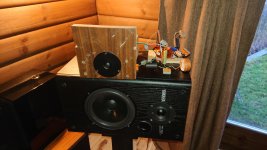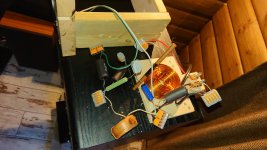Hello, I came from this old thread 'Differences in tweeter's sound by different kind of crossover' in which was said very interesting things which then I wasn't still ready to understand but now I may do.
In particular 'Cyberstudio' gave some interesting notions about even and odd order filter topology correlated with phase at cross point.
Now I may be ready to understand better these notions so I recall them so:
- given that two complex signals sums up right only when in phase, why an odd-order with two signals apart 90 degrees in phase at -3 dB has a flat power response and an even-order with two signals in phase at -6 dB hasn't a flat power response? In other words, what does it happens to on-axis and off-axis response between these two basic kind of approaches?
- another question: isn't 'sound quality' of two 90 degrees shifted and summed up signals worse than two signals in phase one?
Thank you very much.
ps @Cyberstudio: don't excuse for the basical kind of your explanation for me, I'm just a beginner..
In particular 'Cyberstudio' gave some interesting notions about even and odd order filter topology correlated with phase at cross point.
Now I may be ready to understand better these notions so I recall them so:
- given that two complex signals sums up right only when in phase, why an odd-order with two signals apart 90 degrees in phase at -3 dB has a flat power response and an even-order with two signals in phase at -6 dB hasn't a flat power response? In other words, what does it happens to on-axis and off-axis response between these two basic kind of approaches?
- another question: isn't 'sound quality' of two 90 degrees shifted and summed up signals worse than two signals in phase one?
Thank you very much.
ps @Cyberstudio: don't excuse for the basical kind of your explanation for me, I'm just a beginner..
There are two radiating surfaces working together which changes the result acoustically.why an odd-order with two signals apart 90 degrees in phase at -3 dB has a flat power response and an even-order with two signals in phase at -6 dB hasn't a flat power response? In other words, what does it happens to on-axis and off-axis response between these two basic kind of approaches?
No, it doesn't work like that. What does change is the distribution of sound in the room, and the power to direct sound ratio.another question: isn't 'sound quality' of two 90 degrees shifted and summed up signals worse than two signals in phase one?
another question: isn't 'sound quality' of two 90 degrees shifted and summed up signals worse than two signals in phase one?
Something to be kept in mind is that even when the cone movements align in phase electrically there is no guarantee they are acoustically in phase.
For example: On your typical flat panel speaker, the point of origin for a woofer is far deeper into the cabinet then the one for a dome tweeter. This amounts to a mechanical/acoustic phase shift.
The electrical phase shift may actually time align the two drivers or, less often, make it worse.
Something to be kept in mind is that even when the cone movements align in phase electrically there is no guarantee they are acoustically in phase.
...cut...
The electrical phase shift may actually time align the two drivers or, less often, make it worse.
Sure, I know this, and since I use Boxsim to simulate net I'm able to manage phase and time alignment.
I'm working around a mid/tweeter cross very similar to a 3rd order Butterworth which seems to sound quite good and, on-axis flat: in its simulation at cross-point there are just about 90 degrees of shift between driver's phases. My question is:
- may it be worth to work around this circuitry trying to eliminate phase shift even mounting one driver behind the other's vertical plane? May it sounds better or will zero shift be useless at all in terms of sound quality? Why some cross-over designers seem to give great importance to drivers' time alignment (one of my first building was based just on a famous designer's 3rd order crossover with 0 degrees phase shift at cross-point)?
- what is a skewed lobing pattern typical of 3rd order 90° phase shifted topology?
Thank you.
Last edited:
I don't think anybody understands all the subtleties of Butterworth versus Linkwitz-Riley! In some ways its as mysterious as a car at 60 mph has 4X the energy as one at 30 mph.
I know I don't! 😀
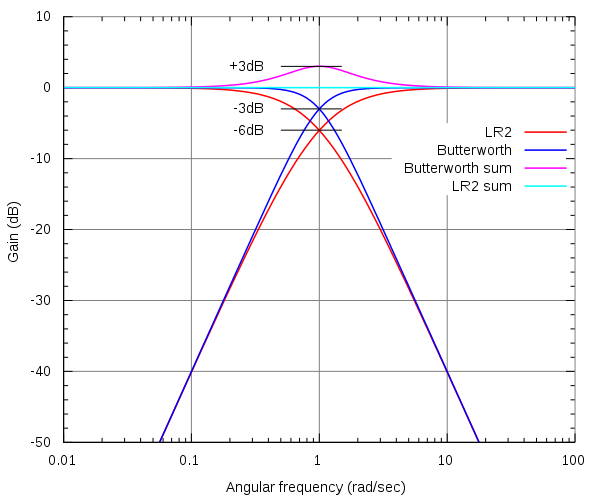
The above image shows the sort of +3dB peak you get with Butterworth in Frequency Response when phase-aligned.
I used to think Butterworth was odd-order, and Linkwitz-Riley even order. But these days I think it's just choice of slopes and filter values. 2-Way Crossover Calculator / Designer
You have to take bafflestep out of the equation to make progress. It confuses things. A good butterworth looks much the same when you flip tweeter polarity. Only the assymetrical vertical lobing flips. This can be fixed with MTM.
Butterworth will give you flat impedance and power response if you are lucky. Linkwitz-Riley tends to the usual omega-shape impedance bump in the midrange and flat frequency response.
Boxsim does what it does. The optimiser leans towards phase-alignment along with flat frequency response, I usually override it with manual values for Butterworth 90 degree phase-alignment. You can also adjust time-alignment for a quarter wavelength adjust. 2.5cm being a quarter wavelength at 3kHz.
This must be the most misunderstood speaker in the Universe, for all the endlessly repeating stuff I have heard about it:
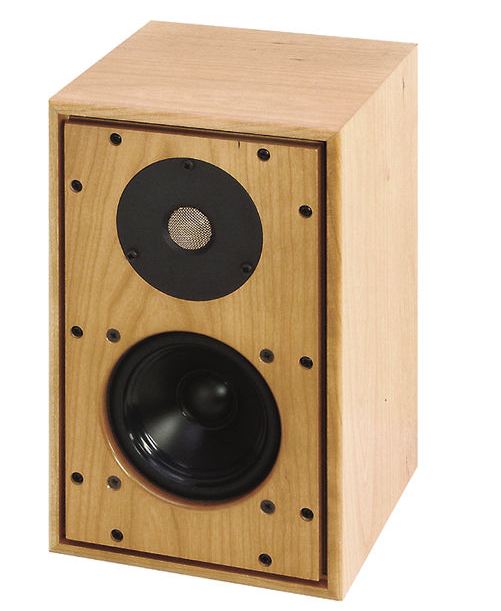
The BBC LS3/5A and its derivatives. I am very sure it's a 18dB/octave Butterworth with a recessed Bass and negative polarity. I suspect what is good about it is a flat power response on voices.
I have done a lot of "Butterworthy" filters:
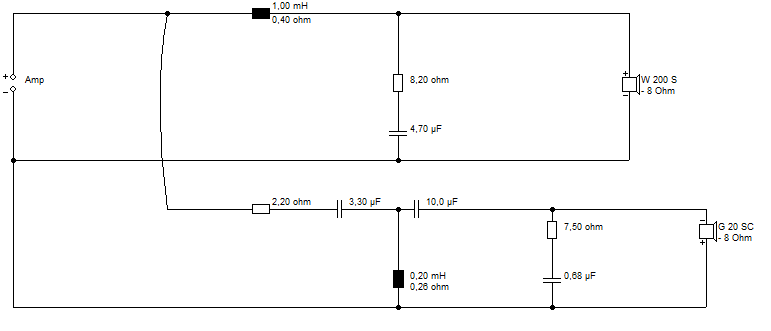
This one has a quite good power response, or at least, I have seen worse power hoies from mid to tweeter:
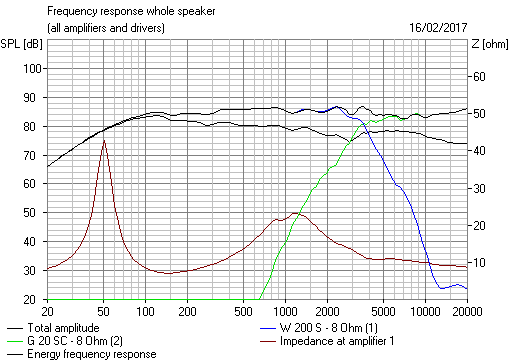
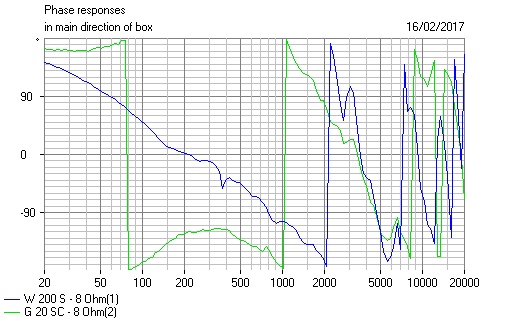
Where the phase-alignment loses it, at least it's filling the power hole. I suppose we are trying to get to 90 degrees which also flattens frequency response at the price of assymettric lobing, above and below axis.
More research needed: Flat Impedance and Flat Power response design.
I know I don't! 😀
The above image shows the sort of +3dB peak you get with Butterworth in Frequency Response when phase-aligned.
I used to think Butterworth was odd-order, and Linkwitz-Riley even order. But these days I think it's just choice of slopes and filter values. 2-Way Crossover Calculator / Designer
You have to take bafflestep out of the equation to make progress. It confuses things. A good butterworth looks much the same when you flip tweeter polarity. Only the assymetrical vertical lobing flips. This can be fixed with MTM.
Butterworth will give you flat impedance and power response if you are lucky. Linkwitz-Riley tends to the usual omega-shape impedance bump in the midrange and flat frequency response.
Boxsim does what it does. The optimiser leans towards phase-alignment along with flat frequency response, I usually override it with manual values for Butterworth 90 degree phase-alignment. You can also adjust time-alignment for a quarter wavelength adjust. 2.5cm being a quarter wavelength at 3kHz.
This must be the most misunderstood speaker in the Universe, for all the endlessly repeating stuff I have heard about it:
The BBC LS3/5A and its derivatives. I am very sure it's a 18dB/octave Butterworth with a recessed Bass and negative polarity. I suspect what is good about it is a flat power response on voices.
I have done a lot of "Butterworthy" filters:
This one has a quite good power response, or at least, I have seen worse power hoies from mid to tweeter:
Where the phase-alignment loses it, at least it's filling the power hole. I suppose we are trying to get to 90 degrees which also flattens frequency response at the price of assymettric lobing, above and below axis.
More research needed: Flat Impedance and Flat Power response design.
Last edited:
Well, electrically speaking (note major caveat), assuming odd-order filters, then Butterworth types actually sum flat at Fc, not +3dB. Assuming 3rd order, it sums flat 270 degrees apart in phase; flip the tweeter polarity and it's 90 degrees, but still sums flat. Only even order Butterworth filters sum to +3dB at Fc.
Even order LR filters sum flat at Fc; technically there is no such thing as an odd-order LR filter, but you can create something akin.
In terms of lobing & power response, John Kreskovsky has a good page illustrating the differences of different filters assuming a reasonable 'real world' physical separation between a tweeter & woofer: Power
Even order LR filters sum flat at Fc; technically there is no such thing as an odd-order LR filter, but you can create something akin.
In terms of lobing & power response, John Kreskovsky has a good page illustrating the differences of different filters assuming a reasonable 'real world' physical separation between a tweeter & woofer: Power
...My question is:
- may it be worth to work around this circuitry trying to eliminate phase shift even mounting one driver behind the other's vertical plane?
You mean use electrically symmetrical filters? Yes, you can to a point by either
-Tilting the front baffle to ensure the acoustical centres of the drivers are on the same vertical plane
-Using a stepped front baffle to achieve the same, or
-Moving the listening axis to that of the woofer: the greater distance to the tweeter can then provide some of the delay desired.
All of these approaches have their issues. A tilted baffle inherently means you are now working with the tweeter's off-axis response & you may (may) have some HF loss as a result. Can be mitigated by careful driver selection & design. A stepped baffle introduces greater diffraction, or the potential thereof, and the latter limits you in terms of positioning.
May it sounds better or will zero shift be useless at all in terms of sound quality?
Well, you'll never get zero phase shift / phase rotation in the real world, although you can get reasonably close to a linear phase. Whether it's worth it is a matter of debate. Toole et al found that in most practical conditions, it was inaudible. Others violently disagree, although AFAIK they do not have the kind of experimental results that Toole & others obtained.
Why some cross-over designers seem to give great importance to drivers' time alignment (one of my first building was based just on a famous designer's 3rd order crossover with 0 degrees phase shift at cross-point)?
Personal preference, fashion, marketing, and a host of other reasons. One point to keep in mind: you may have good phase alignment at the crossover frequency with, say, an LR4, but that does not mean that there is no phase shift at all elsewhere.
All great suggestions, thank you very much, in my slow and difficult self-taught crossover designer career I've always thought that phase-shift at cross-point involved a sort of blurring in final musical response in that frequency zone, and this affected me in every experimental design.
Being able to free myself from this belief could be the greatest conquest in my diyaudio life!
Being able to free myself from this belief could be the greatest conquest in my diyaudio life!
I have done a lot of "Butterworthy" filters:

This one has a quite good power response, or at least, I have seen worse power hoies from mid to tweeter:

Very beautiful design System7! It just seems to me strange that with just a coil and a RC impedance correction woofer rolls off in that way. More, with its VAS and QTS that woofer could be put in a bigger enclosure and gain more extension, what do you think?
All these variations on a theme! Life seems too short to try them all! 😱
Time-aligned, for instance. A GOOD thing with 6" drivers, IMO. They are the worst ones to align!
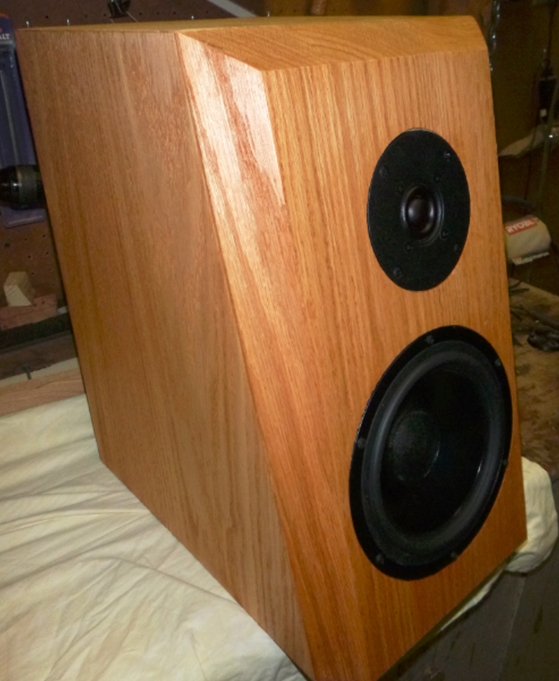
This 8" plus 1" is a sort of "one size fits all" design. Most people like it. It's an old KEF T27 top end, so can't go far wrong. Worth trying a 22R + 0.68uF or 0.47uF tank on the bass coil to take out some 6kHz bass breakup, which does far more than you might expect towards the quiet and clean sound. And yes, it has more bass in reflex.

Big woofers have a natural 18dB/octave rolloff, tweeters often 12dB/octave. So not much work needed.
John Kreskovsky always goes over my head, since I am not an algebra type of person. But graphs I understand:
If you look at the mid and tweeter here, that is a very clean 90 degrees:
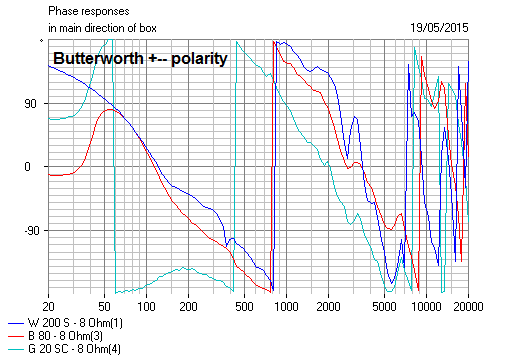
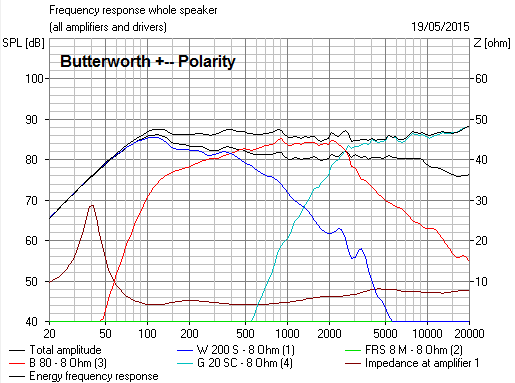
Part of a three way with a fullranger B80 Visaton as mid. It really works in either polarity, which is what we look for with Butterworth. What you don't do is look for the deep crossover null, so it breaks the rules. And power response to die for!
If there is a method for Butterworth, try a phase aligned LR4, and take out an order on both drivers. Should be about right. I'll get my soldering iron out today, and try some cone tweeter stuff.
Time-aligned, for instance. A GOOD thing with 6" drivers, IMO. They are the worst ones to align!
This 8" plus 1" is a sort of "one size fits all" design. Most people like it. It's an old KEF T27 top end, so can't go far wrong. Worth trying a 22R + 0.68uF or 0.47uF tank on the bass coil to take out some 6kHz bass breakup, which does far more than you might expect towards the quiet and clean sound. And yes, it has more bass in reflex.
Big woofers have a natural 18dB/octave rolloff, tweeters often 12dB/octave. So not much work needed.
John Kreskovsky always goes over my head, since I am not an algebra type of person. But graphs I understand:
If you look at the mid and tweeter here, that is a very clean 90 degrees:
Part of a three way with a fullranger B80 Visaton as mid. It really works in either polarity, which is what we look for with Butterworth. What you don't do is look for the deep crossover null, so it breaks the rules. And power response to die for!
If there is a method for Butterworth, try a phase aligned LR4, and take out an order on both drivers. Should be about right. I'll get my soldering iron out today, and try some cone tweeter stuff.
Last edited:
Thank you Steve! Have good time with your soldering iron : )
Just another question, what do you think about baffle-less mid and tweeter systems, that is mounting midrange and tweeter in a way that I can move them independently back and forth to freely adjust time alignment at the expense of null or minimal baffle for each driver?
Just another question, what do you think about baffle-less mid and tweeter systems, that is mounting midrange and tweeter in a way that I can move them independently back and forth to freely adjust time alignment at the expense of null or minimal baffle for each driver?
I've actually been thinking about a similar idea!
Speaker I really liked was the Wharfedale E70 back in the day when I was listening to dull three-way BBC designs:
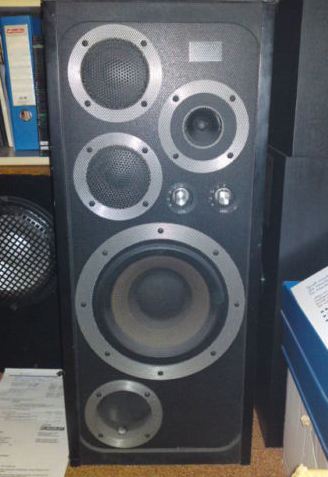
What this high efficiency (series wired twin mid) speaker did extremely well was clarity on vocals. You could hear every word.
Which is a bit weird, because we know that series wired MTM has half power on lower midrange. But better presence.
So my current thinking is to get a couple of planet10's favourite Mark Audio CHN-50 fullrangers in MTM for each speaker above 1kHz: CHN-50 full range driver | KJF Audio
Add a little 3/4" regular tweeter for air above 5kHz. Because the ear is not very discriminating above that point.
Now the theory says the CHN-50 needs 1L box behind it. But would adjustable and open baffle be the end of the World? The reflection off the back wall can't exceed full power. Hope I explained that properly... 😱
Speaker I really liked was the Wharfedale E70 back in the day when I was listening to dull three-way BBC designs:
What this high efficiency (series wired twin mid) speaker did extremely well was clarity on vocals. You could hear every word.
Which is a bit weird, because we know that series wired MTM has half power on lower midrange. But better presence.
So my current thinking is to get a couple of planet10's favourite Mark Audio CHN-50 fullrangers in MTM for each speaker above 1kHz: CHN-50 full range driver | KJF Audio
Add a little 3/4" regular tweeter for air above 5kHz. Because the ear is not very discriminating above that point.
Now the theory says the CHN-50 needs 1L box behind it. But would adjustable and open baffle be the end of the World? The reflection off the back wall can't exceed full power. Hope I explained that properly... 😱
Last edited:
- may it be worth to work around this circuitry trying to eliminate phase shift even mounting one driver behind the other's vertical plane?
If, as you say the sound quality is adequate, I see no reason to complicate the crossover or box designs.
Remember that phase relationships are only crucial at the crossover points where you have more than one driver producing the same sound. Adding parts to fix that might well have adverse effects on other parts of the system.
- what is a skewed lobing pattern typical of 3rd order 90° phase shifted topology?
I'll defer to the "box guys" on this one... 😉
If, as you say the sound quality is adequate, I see no reason to complicate the crossover or box designs.
Thank you, unfortunately I have to say that sound quality is 'rather' adequate, I'm still fighting with a SSSSSS sibilance problem that's making me become mad.
Talking about mid/tweeter cross (Vifa TC9FD18 used as midrange and Scanspeak D2905-9500) I started from a 'quasi' LR2 topology, resulting a disaster in sound, and I'm migrating to a 'quasi' QB3 topology trying to improve the situation.
I've already added a cell and modified consequently tweeter stage (migrating from a time-aligned situation to a 45° phase-shift) and situation improved much but still there's something troublesome, still in SSSS rendering. This is the reason of this thread, asking if phase-shift may affect sound quality.
I hope to be able modifying midrange stage adding another cell in this weekend and I'll let you know, perhaps with some measurement and opening a new thread.
If yet you have some suggestions to do about this issue it'll be really appreciated!
Thank you very much.
Yes it seems it can. A difference in sibilance was one of the main things heard between the two preamps in this test, the largest difference between them was bandwidth, one was 100kHz the other 1MHz. Can you hear a difference between 2 solid state preamps?This is the reason of this thread, asking if phase-shift may affect sound quality.
I'm fighting the same fight as you. I have done a lot of experimenting lately. I have found that the issue in my case was both amp and speakers. I have been playing with waveguides, first order, second order fourth order crossovers. Vifa paper and poly cone woofer, thinking it had to be the woofers fault somehow.
Now I am testing Steve's 3,5khz 3.bw, and it helped a lot. And going from 1 inch to 0,75 inch tweeter helped a bit.
I have on order Monacor HT22 and GRS red phenolic ring cone tweeters. I am hoping they will remove that tiny bit of sibliance I have left.
I have a Roksan Blak amplifier, and while it has a bit annoying sibliance sometimes, it also has some sonic traits I hold dear.
In my search for sibliance remedy I borrowed 2 other integrated amps to test against my Roksan. Yamaha AS 2100 and Parasound Hint. 3 very different sounding amplifiers, all having different strengths and weaknesses. With the Yamaha the sibliance was not an issue. Very warm sounding with it's mosfet output stage. The Hint somewhere in the middle.
But none of the others had the Blak's firecracker speed, dynamics and midbass punch.
A song that made the differences crystal clear was Bryan Ferry's When She Walks In The Room.
On the Yamaha and Parasound it is a sweet little tune, on the Roksan you get all the little background instruments popping, the small shifts in tempo sounds much more dramatic, the song grabs you in a whole other way.
Sorry for the long post, I'm just crossing fingers and hoping that one of the cone tweeters will just give me that fraction less sibliance.
A couple of pics of my crude test rig.
Now I am testing Steve's 3,5khz 3.bw, and it helped a lot. And going from 1 inch to 0,75 inch tweeter helped a bit.
I have on order Monacor HT22 and GRS red phenolic ring cone tweeters. I am hoping they will remove that tiny bit of sibliance I have left.
I have a Roksan Blak amplifier, and while it has a bit annoying sibliance sometimes, it also has some sonic traits I hold dear.
In my search for sibliance remedy I borrowed 2 other integrated amps to test against my Roksan. Yamaha AS 2100 and Parasound Hint. 3 very different sounding amplifiers, all having different strengths and weaknesses. With the Yamaha the sibliance was not an issue. Very warm sounding with it's mosfet output stage. The Hint somewhere in the middle.
But none of the others had the Blak's firecracker speed, dynamics and midbass punch.
A song that made the differences crystal clear was Bryan Ferry's When She Walks In The Room.
On the Yamaha and Parasound it is a sweet little tune, on the Roksan you get all the little background instruments popping, the small shifts in tempo sounds much more dramatic, the song grabs you in a whole other way.
Sorry for the long post, I'm just crossing fingers and hoping that one of the cone tweeters will just give me that fraction less sibliance.
A couple of pics of my crude test rig.
Attachments
I'm fighting the same fight as you. I have done a lot of experimenting lately. ...CUT...
This is the same fight field of mine:

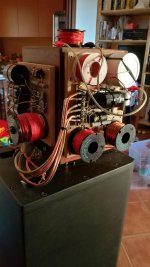
My century's project, my definitive idea, quite one year of work, a lot of time and money spent, lot of basic measurements apparently good in response, which now risks to fly out from the window for this not loud but terrific problem. My wife is afraid that I'm becoming sick (I can call butterworth's syndrome..), since when we listen something I run every 5 minutes changing on the fly some component's value..
I think you're right, haven't thought yet that problem may be in amplifier, quite 25 years old, a beautiful Marantz PM78, now I remember that measurements was made every time using another amp..
Maybe problem isn't in response but in distortion, from amp? from a somewhat damaged (by past experiments) tweeters?
Next sunday I'll take away another day by my family to verify these hypothesis and let you know, thank you very much for suggestions, hope we'll solve this issue, I began to lose sleep for the anger..!
This is just my guess, but I think the problem is in the 5-7khz area. Taking my Vifa woofers as high as they would go up in crossover frequency made the problem smaller, but not completely gone.
I'm starting to think it is a soft dome thing, coupled with a typical bipolar transistor amplifier sounding a bit rough in the same frequency area. I have not had the issue to the same extent with mosfet and tube amps.
I used to run old Klipsch speakers, like Forte, Cornwall and Heresy speakers. They seemed a bit rough around the edges and fairly bright with a tilted up top end, but they didn't have that sssss sound to them.
I'm starting to think it is a soft dome thing, coupled with a typical bipolar transistor amplifier sounding a bit rough in the same frequency area. I have not had the issue to the same extent with mosfet and tube amps.
I used to run old Klipsch speakers, like Forte, Cornwall and Heresy speakers. They seemed a bit rough around the edges and fairly bright with a tilted up top end, but they didn't have that sssss sound to them.
My trouble and concern is that my tweeters come from a far build of 'The new Vifa tower" by Murphy Blaster, where they was cut lower (2000 Hz) than now (3000 Hz), but there wasn't any ssss issue, the same tweeters had there an excellent behaviour and response.
Now, even using them alone in the actual configuration, I can listen sibilance. Hope is amp's age fault.
I'll let you know, good luck!
Now, even using them alone in the actual configuration, I can listen sibilance. Hope is amp's age fault.
I'll let you know, good luck!
- Home
- Loudspeakers
- Multi-Way
- An explanation about filter topology and phase around cross point
